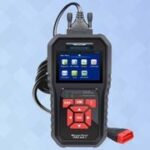The sudden appearance of a check engine light can be unsettling, especially when you’re on the road. While it might signal a serious engine problem, it’s often a minor issue. Modern vehicles have onboard diagnostic (OBD) systems that monitor various components and store diagnostic trouble codes (DTCs) when something goes wrong. Usually, you’d use an OBD2 scanner to read these codes and understand the problem. But what if you don’t have a scanner? Fortunately, there are methods to access these codes even without an OBD ii scanner.
Understanding Your Check Engine Light Without a Scanner
Before diving into methods to retrieve codes, it’s important to understand what your check engine light is telling you through its color. The way your check engine light appears can give you an initial idea of the severity of the issue.
Solid Yellow or Orange Check Engine Light: A steady yellow or orange light indicates that your OBD system has detected a problem, but it’s likely not an emergency. The system isn’t compensating for the fault properly, and it needs attention. While you can usually drive for a short distance, ideally under 100 miles, you should investigate the cause soon. Reading the OBD2 codes is the next step to pinpoint the issue.
Solid Red Check Engine Light: A solid red light, without flashing, suggests a more urgent problem. It needs attention sooner rather than later, though it might not be catastrophic. It’s recommended to drive directly to a trusted mechanic or repair shop for diagnosis and repair when you see a solid red check engine light.
Flashing Check Engine Light: A blinking or flashing check engine light is a serious warning, often indicating engine misfires. This can cause significant damage if ignored. If your check engine light is flashing, pull over as soon as safely possible and seek professional help, like roadside assistance or a tow to a repair facility.
Alt text: Check engine light illuminated on a car dashboard, indicating a potential vehicle issue.
Why Read OBD2 Codes Without a Scanner?
While OBD2 scanners are the most convenient way to read diagnostic codes, there are situations where you might need to access them without one. Perhaps you are:
- In an emergency situation: You’re on a road trip or in a remote area without access to an auto parts store or scanner.
- Trying to save money: You want to avoid the cost of buying a scanner for a one-time check.
- Learning about car diagnostics: You’re curious about DIY car maintenance and want to explore alternative methods.
Knowing how to read OBD2 codes without a scanner can be a valuable skill for any car owner.
Methods to Read Car Engine Codes Without a Reader
While not as straightforward as using a dedicated scanner, several methods can help you retrieve diagnostic trouble codes without one. These methods often involve using your vehicle’s built-in systems.
Method 1: Using the Odometer Reset Button
This method utilizes your car’s odometer reset function to display diagnostic codes. It might work on some vehicles, particularly older models.
Steps:
- Press and hold the odometer reset button.
- While holding the reset button, press and hold the trip button.
- Keeping both buttons pressed, turn the ignition switch to the “on” position (do not start the engine).
- Release both the odometer reset and trip buttons.
- Observe the odometer display. Diagnostic trouble codes, if accessible through this method, should appear in the odometer display. Record any codes shown.
Alt text: Close-up of a car odometer displaying mileage, used in a method to retrieve OBD2 codes without a scanner.
Method 2: Odometer Reset with Multiple Ignition Cycles
If the first odometer method doesn’t work, your car might require multiple ignition cycles to show the codes. This is a variation of the previous method.
Steps:
- Press and hold both the odometer reset and trip buttons.
- While holding, turn the ignition switch to the “on” position.
- Hold the buttons, and turn the ignition switch back to the “off” position.
- Without releasing the buttons, turn the ignition switch back to the “on” position again.
- Release the odometer reset and trip buttons while the ignition remains in the “on” position.
- Check the odometer display for any diagnostic trouble codes. Note them down.
Method 3: The Ignition Key and Dashboard Light Pulses (OBD1 & Some OBD2)
This method is more common for older vehicles with OBD1 systems, but might also work for some early OBD2 cars. It involves observing the check engine light for a series of flashes that represent the diagnostic code. This method requires careful observation.
Steps:
- Turn the ignition key “on” and “off” rapidly three to five times, without starting the engine. End with the ignition in the “on” position.
- Confirm that all dashboard warning lights illuminate, indicating you’ve cycled the ignition correctly.
- Wait for all lights to turn off, except the check engine light.
- Check if a DTC appears in the odometer display (some OBD2 vehicles may show codes here).
- If no code appears in the odometer, carefully watch the check engine light. It will flash in a pattern of pulses and pauses.
Interpreting the Pulses:
- Count the number of flashes (pulses). Each pulse represents a digit of the code.
- A longer pause separates the digits of a multi-digit code.
Example: Five flashes, PAUSE, then three flashes would be interpreted as code 53. You’ll need to look up OBD1 code charts online to understand what these codes mean for your specific vehicle make and model.
Method 4: Using a Paperclip or Jumper Wire (OBD1)
This method is specifically for OBD1 systems and involves manually bridging terminals in the OBD port to trigger the code display. This method is generally not recommended for OBD2 vehicles and could potentially cause damage if done incorrectly. Proceed with caution and only if you are sure your vehicle uses an OBD1 system.
Steps (OBD1 Vehicles Only):
- Ensure the car is turned completely off.
- Locate the OBD1 diagnostic port, usually under the dashboard or hood.
- Identify the diagnostic terminals. (Consult your vehicle’s repair manual or online resources for the specific terminals to bridge for your car model).
- Using a paperclip or jumper wire, carefully connect the specified terminals to create a closed circuit.
- Turn the ignition switch to the “on” position (do not start the engine).
- Observe the check engine light for flashing patterns, as described in Method 3, and record the pulses and pauses to determine the trouble codes.
Alt text: A paperclip inserted into an OBD1 diagnostic port, illustrating a method to read engine codes without a scanner on older vehicles.
Limitations of Reading OBD2 Codes Without a Scanner
While these methods can sometimes provide diagnostic codes without a scanner, they have significant limitations:
- Vehicle Compatibility: Not all vehicles support these methods. They are more likely to work on older models.
- Code Specificity: The codes retrieved might be generic and less detailed than what a scanner provides.
- Code Interpretation: You’ll need to manually look up the codes, which can be time-consuming and require reliable code charts specific to your vehicle.
- No Live Data: Scanner-less methods only retrieve stored codes, not real-time data about engine performance, which is crucial for diagnosing complex issues.
- Risk of Misinterpretation: Especially with pulse counting, there’s a higher chance of misinterpreting the codes, leading to incorrect diagnoses.
- OBD1 Focus: Methods like paperclip bridging are strictly for OBD1 and risky for OBD2.
When to Use a Scanner vs. Scanner-less Methods
-
Use a Scanner When:
- You want a quick, accurate, and detailed diagnosis.
- You need to read live engine data.
- You want to clear codes after repairs.
- You regularly perform car maintenance.
- You own a newer vehicle with an OBD2 system.
-
Consider Scanner-less Methods When:
- You are in an emergency and have no access to a scanner.
- You own an older vehicle and are comfortable with DIY methods.
- You understand the limitations and risks involved.
- You are primarily looking for a general idea of the problem, not a precise diagnosis.
Seeking Professional Help is Always Recommended
Even if you successfully retrieve OBD2 codes without a scanner, it’s crucial to remember that these methods are not a substitute for professional diagnostics. Diagnostic trouble codes are just a starting point. A certified mechanic has the expertise, tools, and comprehensive scanners to:
- Accurately diagnose the root cause of the problem, which might be more complex than the code suggests.
- Perform thorough inspections and tests.
- Recommend the correct repairs.
- Ensure the repair is done properly.
Taking your vehicle to a qualified mechanic ensures accurate diagnosis and effective repair, getting you safely back on the road.
Protect Yourself from Unexpected Repair Costs
While understanding your check engine light is important, unexpected car repairs can be expensive. An extended warranty or vehicle protection plan from Endurance Warranty can provide peace of mind and financial security against costly mechanical breakdowns. Endurance offers various plans to fit different budgets and vehicle types, protecting you from unforeseen repair bills and keeping your car running smoothly. Don’t wait for the check engine light to become a major financial burden. Explore Endurance Warranty options today to safeguard your vehicle and your wallet.
Request a free, no-obligation quote for an auto protection plan or call (800) 253-8203 to speak with an Endurance representative. Learn more about car care and maintenance on our blog.


